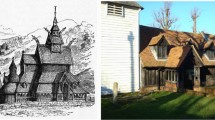Summary
An experimental investigation of glass fibre reinforcement of glued laminated timber beams is presented. A polyester resin is used both as matrix and adhesive between the reinforcement and the wood. The main part of the work considers beams with large holes tested in three point bending. Circular and rectangular holes, centred at quarter length of the beams make the strength of wood perpendicular to the grain become critical. Great improvements of strength are obtained with the glass fibres. A comparison between various kinds and combinations of glass fibre reinforcement is made. Further, the reinforcement applied as repair of earlier cracked beams is investigated with positive results. One series of beams without holes is reinforced and tested in four-point bending.
Similar content being viewed by others
References
ASTM D2584-68 (Reapproved 1985): Standard test method for ignition loss of cured reinforced resins.
Blom, A.; Bäcklund, J. 1980: Composite material reinforcement of cutouts in laminated timber beams. Department of Mechanical Engineering, Linköping Institute of Technology (Sweden)
Botten, N. P. 1993: Fiberkomposittforsterkning av limtre — Bolteforbindelser. (in Norwegian) The Norwegian Institute of Wood Technology, Oslo
Carling, O.; Johannesson, B. 1988: Limträhandboken 1988 (in Swedish) Stockholm: Svenskt Limträ
Dahlbom, O.; Enquist, B.; Gustafsson, P. J.; Knudsen, R.; Larsen, H. J.; Omarsson, S.; Traberg, S. 1993: Advanced materials based on strew and wood. Fibre reinforcement of glulam. Rep. 1–7. Department of Structural Engineering, Technical University of Denmark and Division of Structural Mechanics, Lund Institute of Technology (Sweden)
ISO 3268, First edition-1978: Plastics-glass-reinforced materials — Determination of tensile properties
Larsen, H. J.; Gustafsson, P. J.; Enquist, B. 1992: Tests with glass-fibre reinforcement of wood perpendicular to the grain. Rep. TVSM-7067. Division of Structural Mechanics, Lund Institute of Technology (Sweden)
Moulin, J. M.; Pluvinage, G.; Jodin, P. 1990: FGRG: Fibreglass reinforced gluelam — A new composite. Wood Sci. Technol. 24: 289–294
Rowlands, R. E.; Van Deweghe, R. P.; Laufenberg, T. L.; Krueger, G. P. 1986: Fiber-reinforced wood composites. Wood Fiber Sci. 18(1), pp. 39–57
SBN 1975: Determination of load-bearing capacity by testing. The National Board of Physical Planning and Building. Approval rules No. 1975:4 Stockholm: Liber Förlag
Tingley, D. 1988: Reinforced glued-laminated wood beams. Wood Science and Technology Institute, Inc., Fredericton, New Brunswick (Canada)
Triantafillou, T. C.; Deskovic, N. 1992: Prestressed FRP sheets as external reinforcement of wood members. J. Struct. Eng. Vol. 118, No. 5
Author information
Authors and Affiliations
Additional information
This reseach project was initiated to improve the ability of glued laminated timber to compete with steel and concrete, in large free span constructions. The project was funded by the Nordic Industrial Fund (NI), Svenskt Limträ AB and the Swedish National Board for Industrial and Technical Development (NUTEK)
Rights and permissions
About this article
Cite this article
Hallström, S. Glass fibre reinforced holes in laminated timber beams. Wood Sci.Technol. 30, 323–337 (1996). https://doi.org/10.1007/BF00223552
Received:
Issue Date:
DOI: https://doi.org/10.1007/BF00223552




